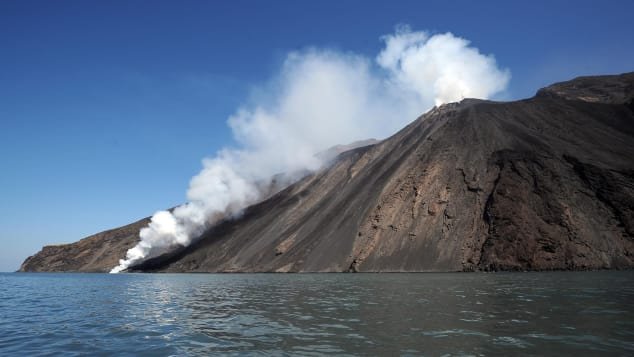Volcanic eruptions, Stromboli, Italy

Part of the Aeolian Islands off the coast of Sicily, Stromboli is a small volcanic island with several hundred brave inhabitants. Unlike most volcanoes, Stromboli's is constantly spewing lava fountains, gas and ash. Fascinating for volcanologists, but also great for day-trippers who fancy seeing live lava action.
For natural fireworks, take a boat trip around the island at night. Arrange boat tours from harbors on the north coast of Sicily (Messina, Cefalu, Palermo).
Stromboli (Italian pronunciation: [ˈstromboli]; Sicilian: Struògnuli, Ancient Greek: Στρογγύλη, Strongulē) is a small island in the Tyrrhenian Sea, off the north coast of Sicily, containing one of the three active volcanoes in Italy. It is one of the eight Aeolian Islands, a volcanic arc north of Sicily. This name is derived from the Ancient Greek name Strongulē which was given to it because of its round swelling form. The island's population is about 500.
The volcano has erupted many times and is constantly active with minor eruptions, often visible from many points on the island and from the surrounding sea, giving rise to the island's nickname "Lighthouse of the Mediterranean".
Stromboli's most recent major eruption was on April 13, 2009. Stromboli stands 926 m (3,034 ft) above sea level, and over 2,700 m (8,860 ft) on average above the sea floor.[5] There are three active craters at the peak. A significant geological feature of the volcano is the Sciara del Fuoco ("stream of fire"), a big horseshoe-shaped depression generated in the last 13,000 years by several collapses on the northwestern side of the cone. Two kilometers to the northeast lies Strombolicchio, the volcanic plug remnant of the original volcano.
Eruption of Stromboli (animated)
Mt. Stromboli has been in almost continuous eruption for the past 2,000 years. A pattern of eruption is maintained in which explosions occur at the summit craters, with mild to moderate eruptions of incandescent volcanic bombs, at intervals ranging from minutes to hours. This Strombolian eruption, as it is known, is also observed at other volcanoes worldwide. Eruptions from the summit craters typically result in a few short, mild, but energetic bursts, ranging up to a few hundred meters in height, containing ash, incandescent lava fragments and stone blocks. Stromboli's activity is almost exclusively explosive, but lava flows do occur at times when volcanic activity is high: an effusive eruption occurred in 2002, the first in 17 years, and again in 2003, 2007, and 2013–14. Volcanic gas emissions from this volcano are measured by a Multi-Component Gas Analyzer System, which detects pre-eruptive degassing of rising magma, improving prediction of volcanic activity.
image source: https://edition.cnn.com/travel/article/natural-wonder-bucket-list/index.html